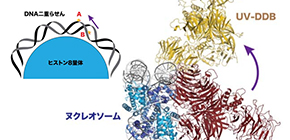
Mechanisms to detect and repair UV-induced DNA lesions clarified
A group of researchers from Kobe University, The University of Tokyo, and Osaka University, in cooperation with The Friedrich Miescher Institute for Biomedical Research, unveiled a molecular level mechanism to detect a UV-damaged genome DNA, which is densely packed in nucleosomes, to initiate repair.
DNA damage occurs in each cell tens of thousands of times a day. If the repair work cannot keep up with the rate at which damage builds up, interference of replication and transcription of DNA, cell death, and chromosomal instability are caused, leading to cancerization of cells. Thus, DNA repair is essential for the proper function and survival of cells.
Ultraviolet (UV) light damages DNA, producing small lesions. The UV-damaged DNA-binding protein (UV-DDB) complex detects UV-damaged DNA and initiates repair, by which preventing the onset of skin cancer. The UV-DDB complex, which comprises the subunits DDB1 and DDB2, detects and binds the lesion to initiate repair. Mutations in DDB2 causes xeroderma pigmentosum, increasing risk of skin cancer by UV irradiation.
Access to DNA packaged in nucleosomes is critical for gene regulation, DNA replication and DNA repair. UV induces the formation of pyrimidine dimers, which interfere with replication and transcription of DNA and hence are potentially toxic and mutagenic to cells. In humans, the UV-DDB complex detects these UV-light-induced pyrimidine dimers. However, nucleosomes in chromatin restrict access to DNA, so how these lesions are recognized in chromatin was unknown.
This group examined the structure of UV-DDB bound to a nucleosome containing a lesion at a specific position to reveal its configuration, finding that even when a lesion was in an exposed position, that is, the farthest away from histone proteins at the center, UV-DDB was able to bind to the damage region without affecting the overall nucleosome architecture.
They also examined the effect of the nucleosomal DNA positioning strength, finding that nucleosomes with lesions positioned upstream or downstream retained UV-DDB binding, but that there was a decrease in binding strength as the lesion was moved away from the solvent-exposed locus towards the histone core.
These findings explain how UV-DDB detects occluded lesions in strongly positioned nucleosomes and identify slide-assisted site exposure as a mechanism by which high-affinity DNA-binding proteins can access otherwise occluded sites in nucleosomal DNA. They named this mechanism “Slide-Assisted Site-Exposure (SAsSE).”
The results of this group have great significance in the elucidation of the DNA repair process. If these repair processes are artificially controlled, it will lead to the application to protection from UV light and the development of preventive drugs for skin cancer.

Figure 1

Figure 2
The article, "DNA damage detection in nucleosomes involves DNA register shifting" was published in the Nature at DOI: https://doi.org/10.1038/s41586-019-1259-3 .
Related links

